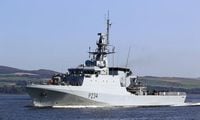On June 18, 2025, the British Royal Navy's offshore patrol vessel HMS Spey sailed through the Taiwan Strait, reaffirming the United Kingdom's commitment to freedom of navigation and the rules-based international order in one of the world's most strategically sensitive waterways. This transit, confirmed and welcomed by Taiwan's Ministry of Foreign Affairs, was conducted in full compliance with international law under the United Nations Convention on the Law of the Sea (UNCLOS), underscoring the strait's status as international waters.
The Taiwan Strait, a 110-mile-wide channel separating Taiwan from mainland China, has long been a flashpoint in regional tensions. China claims sovereignty over Taiwan and views the strait as its territorial waters, a position firmly rejected by Taiwan, which operates as a self-governing democratic island. The British transit of HMS Spey follows a pattern of freedom of navigation operations by like-minded countries, including the United States and Japan, aimed at safeguarding peace and stability in the Indo-Pacific region.
According to the British Office in Taipei, HMS Spey's passage was part of a long-planned deployment and was carried out in accordance with the rights provided under UNCLOS. The Royal Navy emphasized that its operations are always conducted in full compliance with international law, exercising the right to freedom of navigation and overflight. The British Embassy reiterated that such transits are not unprecedented; since 2018, Royal Navy vessels have conducted similar patrols 13 times, including the last transit in 2021 by HMS Richmond.
HMS Spey is one of two lightly armed Batch 2 River-class patrol vessels deployed to the Indo-Pacific under the UK’s persistent forward presence strategy. Since 2021, Spey and its sister ship HMS Tamar have been active across Southeast Asia, Oceania, and the Pacific, frequently conducting maritime security patrols and engagement missions. Notably, HMS Spey sailed from Sasebo, Japan, on June 15, 2025, having recently been involved in enforcing United Nations sanctions against North Korea.
Taiwan's Ministry of Foreign Affairs praised the British transit, stating, "The foreign ministry welcomes and affirms the British side once again taking concrete actions to defend the freedom of navigation in the Taiwan Strait, demonstrating its firm position that the Taiwan Strait is international waters." The ministry encouraged like-minded countries to jointly safeguard peace and stability in the strait and promote a free and open Indo-Pacific region.
The passage of HMS Spey comes amid heightened regional tensions. Just days prior, on June 12, 2025, the Japanese Maritime Self-Defense Force destroyer JS Takanami also sailed through the Taiwan Strait, marking the third such transit by a Japanese warship in recent years. The Chinese military closely monitored the Takanami’s passage, which lasted over 10 hours from the East China Sea to the South China Sea. These naval movements occur against a backdrop of frequent Chinese military exercises and assertive maneuvers near Taiwan.
China's response to HMS Spey's transit was swift and sharp. China's Eastern Theater Command condemned the British patrol as a "publicly hyped" stunt and accused the UK of "distorting legal principles and confusing the public." It described the passage as an "intentional provocation" that "disrupts the situation and undermines peace and stability across the Taiwan Strait." The Chinese navy stated it monitored HMS Spey throughout its journey and vowed to "resolutely counter all threats and provocations."
Further, a spokesman for China’s foreign ministry declared that while China respects other countries' rights to navigate the Taiwan Strait, it "firmly opposes any country using the name of freedom of navigation to provoke and threaten China’s sovereign security." These statements reflect Beijing’s sensitive stance on foreign military presence in waters it claims as its own.
The timing of HMS Spey's transit is notable, coinciding with the arrival of a UK carrier strike group led by the aircraft carrier HMS Prince of Wales in the Indo-Pacific for an eight-month deployment involving around 4,000 personnel. British Prime Minister Keir Starmer has described this deployment as one of the carrier's largest this century, aimed at sending "a clear message of strength to our adversaries, and a message of unity and purpose to our allies." The strike group plans to engage with 30 countries and conduct joint exercises with the United States, India, Singapore, and Malaysia.
The broader regional context includes increased Chinese military activity near Japan and Taiwan. On June 7 and 8, 2025, Chinese Shenyang J-15 fighter jets shadowed Japanese patrol aircraft at dangerously close distances, and for the first time, two Chinese aircraft carriers, Shandong and Liaoning, operated simultaneously in the Pacific near Japanese exclusive economic zones. These developments have alarmed Tokyo and heightened concerns about stability in the region.
While the UK and China are reportedly seeking to mend diplomatic relations, with Prime Minister Starmer expected to visit Beijing later this year—the first such visit by a British leader since 2018—the naval transits through the Taiwan Strait underscore ongoing strategic contestations. The British Ministry of Defence has not publicly specified the exact timing of HMS Spey's passage, but Taiwan's foreign ministry confirmed it occurred on June 18.
The last British warship to transit the Taiwan Strait was HMS Richmond in 2021, which also faced Chinese military monitoring and warnings. The United States Navy regularly conducts freedom of navigation operations in the strait, often accompanied by allied navies, approximately once every two months.
In this complex geopolitical environment, the British transit of HMS Spey is more than a routine naval operation—it is a deliberate assertion of international maritime rights and a signal of support for Taiwan and regional allies. As tensions persist and military activities intensify, the Taiwan Strait remains a critical flashpoint where global powers test the balance between sovereignty claims and the principles of free navigation.


